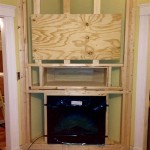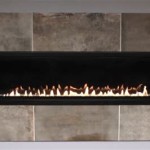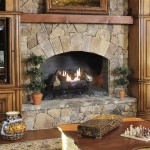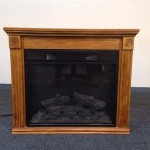Painted Red Brick Fireplace Makeover Ideas
Red brick fireplaces, while historically charming, can often appear dated or clash with contemporary interior design styles. Painting a red brick fireplace offers a transformative opportunity to update the space, create a focal point, and enhance the overall ambiance of a room. This process, however, requires careful consideration of paint types, preparation methods, and design aesthetics to achieve a durable and visually appealing outcome. This article explores various approaches to painting a red brick fireplace, highlighting key considerations and providing practical insights for a successful makeover.
Surface Preparation: The Foundation for a Lasting Finish
Prior to applying any paint, meticulous surface preparation is essential for ensuring proper adhesion and longevity. Neglecting this crucial step can result in peeling, chipping, and an unsatisfactory final appearance. The preparation process typically involves several key stages. First, the brick surface must be thoroughly cleaned to remove any accumulated soot, dust, grease, or other contaminants. A wire brush can be used to scrub away loose debris, followed by a solution of trisodium phosphate (TSP) and water, applied with a sponge or brush. TSP is a powerful degreaser and cleaning agent, particularly effective for removing soot and grime from brick. It is crucial to wear protective gloves and eye protection when working with TSP, as it can be irritating to the skin and eyes.
After cleaning, the brick should be rinsed thoroughly with clean water to remove any residual TSP. Allow the brick to dry completely before proceeding to the next step. This drying process can take several hours or even a full day, depending on the humidity and temperature. Once the brick is dry, inspect the surface for any cracks, gaps, or damaged mortar. These imperfections should be repaired with a cement-based patching compound, specifically designed for masonry. Apply the patching compound according to the manufacturer's instructions, ensuring that it fills the cracks and gaps completely. Allow the patching compound to cure fully before sanding it smooth, blending it seamlessly with the surrounding brick surface. This step is critical for creating a uniform surface that will accept the paint evenly.
Finally, consider applying a masonry primer before painting. A primer serves several important functions. It seals the porous brick surface, preventing the paint from being excessively absorbed. It provides a uniform base for the paint, ensuring consistent color and finish. It also improves the adhesion of the paint, reducing the risk of peeling or chipping over time. Choose a primer specifically designed for masonry surfaces, and apply it according to the manufacturer's instructions. Allow the primer to dry completely before proceeding to the painting stage.
Selecting the Right Paint: Durability and Aesthetics
Choosing the appropriate paint is paramount for achieving a durable and aesthetically pleasing finish. Several paint types are suitable for brick fireplaces, each with its own advantages and disadvantages. Latex acrylic paint is a popular choice due to its durability, ease of application, and wide range of colors. It is also relatively low in volatile organic compounds (VOCs), making it a more environmentally friendly option. However, latex acrylic paint may not be as resistant to heat as some other paint types.
High-heat paint, specifically designed for fireplaces and stoves, is an excellent option if the fireplace will be used frequently. This type of paint is formulated to withstand high temperatures without blistering, cracking, or discoloring. However, high-heat paint typically comes in a limited range of colors and finishes, often in matte or satin sheens. Mineral paint, also known as silicate paint, is another durable and breathable option for painting brick. It penetrates the brick surface, forming a chemical bond that is highly resistant to peeling and cracking. Mineral paint is also naturally mold-resistant and environmentally friendly.
When selecting a paint color, consider the overall aesthetic of the room and the desired effect. White or light-colored paint can brighten up a dark space and create a clean, modern look. Gray or beige paint can provide a more neutral and sophisticated backdrop. Darker colors, such as charcoal or black, can create a dramatic and contemporary statement. It is advisable to test a small area of the brick with the chosen paint color before committing to the entire project. This allows you to assess the color's appearance under different lighting conditions and ensure that it complements the surrounding decor.
In addition to the paint type and color, consider the paint finish. Matte finishes are less reflective and can help to conceal imperfections in the brick surface. Satin finishes offer a slight sheen and are easier to clean than matte finishes. Semi-gloss or gloss finishes are more reflective and durable, but they can also highlight imperfections. Choose a paint finish that is appropriate for the desired aesthetic and the level of wear and tear that the fireplace is likely to experience.
Design Considerations: Achieving the Desired Aesthetic
Beyond the technical aspects of surface preparation and paint selection, design considerations play a crucial role in achieving the desired aesthetic for a painted red brick fireplace. The style of the fireplace should complement the overall design of the room, whether it is traditional, modern, contemporary, or eclectic. Several design approaches can be employed to transform a red brick fireplace into a stunning focal point.
One popular approach is to paint the entire fireplace, including the brick and the surrounding mantel, in a single color. This creates a cohesive and unified look that can seamlessly integrate the fireplace into the room's decor. Choose a color that complements the existing furniture, wall color, and flooring. For a modern look, consider painting the fireplace white or a light gray. For a more traditional look, opt for a warm beige or a soft cream color.
Another option is to paint the brick a different color than the mantel. This can create visual interest and highlight the architectural details of the fireplace. For example, you could paint the brick a dark gray and the mantel white, creating a striking contrast. Alternatively, you could paint the brick a neutral color and the mantel a bold accent color, such as red or blue.
A more advanced design approach involves creating a faux finish on the brick. This can be achieved through various techniques, such as dry brushing, sponging, or stenciling. Dry brushing involves applying a small amount of paint to a dry brush and lightly brushing it across the brick surface. This creates a textured effect that can add depth and dimension to the fireplace. Sponging involves applying paint to the brick surface with a sponge, creating a mottled effect. Stenciling involves using a stencil to apply a decorative pattern to the brick. These techniques require more skill and patience, but they can result in a truly unique and personalized fireplace.
In addition to painting the brick, consider updating the surrounding mantel. The mantel is an important architectural feature that can significantly impact the overall appearance of the fireplace. You can paint the mantel a different color than the brick, or you can replace it entirely with a new mantel made of wood, stone, or metal. You can also add decorative elements to the mantel, such as moldings, corbels, or a decorative shelf. These details can enhance the fireplace's aesthetic appeal and create a more sophisticated look.
Finally, consider the fireplace accessories. The accessories you choose to display on the mantel can further enhance the fireplace's aesthetic. Consider adding candles, vases, picture frames, or decorative objects that complement the room's decor. Choose accessories that are proportional to the size of the mantel and that reflect your personal style. Arranging the accessories in a balanced and visually appealing manner can create a harmonious and inviting focal point.
Practical Application: Painting the Fireplace
Once the surface is prepared, the paint is selected, and the design is finalized, the actual painting process can begin. Applying the paint requires patience and attention to detail to achieve a smooth, even finish. Begin by taping off the surrounding areas, such as the wall and the floor, with painter's tape. This will protect these areas from paint splatters and ensure clean, crisp lines.
Apply the paint using a brush or a roller, depending on the texture of the brick and the desired finish. A brush is ideal for painting intricate details and corners, while a roller is more efficient for covering large, flat surfaces. Use a high-quality brush or roller designed for masonry surfaces. Apply the paint in thin, even coats, allowing each coat to dry completely before applying the next. Avoid applying thick coats of paint, as this can lead to drips, runs, and an uneven finish.
Pay particular attention to the mortar joints between the bricks. Ensure that the paint penetrates these joints fully, as they can be prone to collecting dirt and grime. Use a small brush to carefully paint the mortar joints, ensuring that they are fully covered. If you are painting the brick a different color than the mantel, use painter's tape to mask off the edges of the mantel, creating a clean, crisp line. Remove the painter's tape carefully once the paint has dried completely.
Allow the paint to dry completely before using the fireplace. The drying time will vary depending on the type of paint used and the humidity and temperature. Consult the paint manufacturer's instructions for the recommended drying time. Once the paint is dry, inspect the fireplace for any imperfections or areas that need to be touched up. Use a small brush to touch up any areas that are uneven or have been missed. Clean up any paint splatters or drips immediately with a damp cloth. Dispose of the used paint brushes, rollers, and painter's tape properly. With careful preparation and application, a painted red brick fireplace can become a stunning focal point that enhances the overall aesthetic of the room.

Diy Red Brick Fireplace Makeover Ideas The Nuts

How To Paint A Brick Fireplace

Fireplace Makeover Handmade Weekly

16 Red Brick Fireplace Makeover Ideas

How To Update Your Fireplace 5 Easy Affordable Ideas Brick Makeover Painted Remodel

Mortar Wash Brick Fireplace Makeover Dimples And Tangles

16 Red Brick Fireplace Makeover Ideas

Diy Painted Brick Fireplace Makeover On A Budget Before After The Confused Millennial

Red Brick Fireplace Makeover Before And After Worthing Court

35 Best Diy Painted Brick Fireplace Makeover Ideas Before And After
Related Posts








